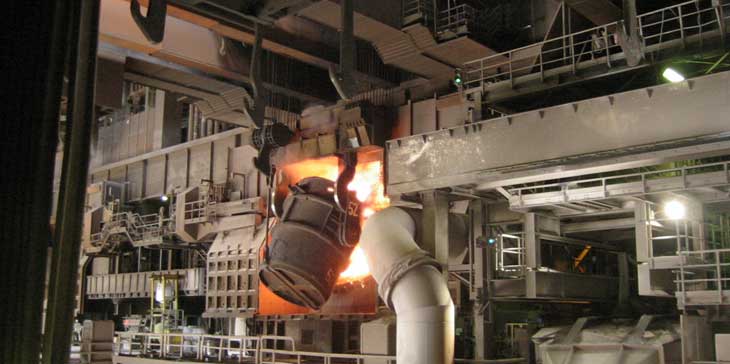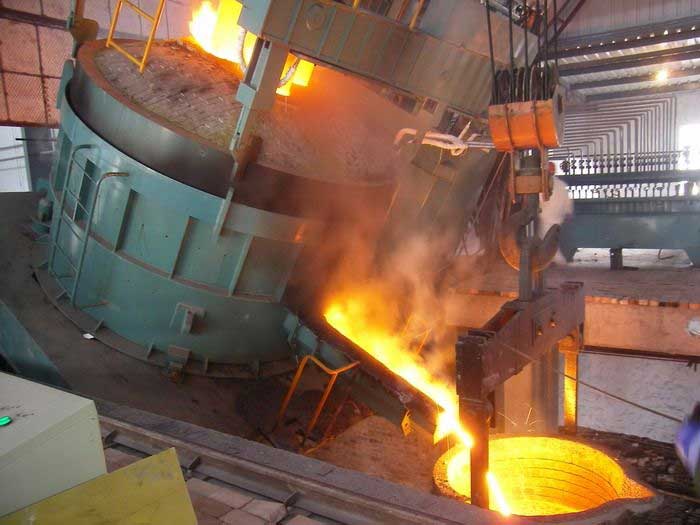Steel making
Steel making Furnaces
To produce steel, facilities use one of two processes.. the basic oxygen furnace (BOF) or the electric arc furnace (EAF).
Basic Oxygen Furnace (BOF)
The basic oxygen furnace is the process in which a mixture of scrap (25 to 30 percent) and hot metal (75 to 70 percent) from the blast furnace is exposed to oxygen blown at a high velocity into the bath. Such furnaces may be top-blown, bottom- blown, or a combination of the two. The basic principle is the same in all cases; the oxygen combines with unwanted elements to form oxides that either leave the bath as gases or enter the slag layer on top of the bath. This is a very high productivity process; a typical 220-ton heat can be produced in 45 minutes or less.
 Basic Oxygen Furnace (BOF)
Basic Oxygen Furnace (BOF)

Electric Furnace (EAF)
Another steelmaking process widely used today is the electric furnace. The furnace charge is generally 100 percent scrap, and an electric arc is used as the heat source for the refining process. The electric furnace is generally not used for deep drawing steel or very light gauge steel because of its inability to reduce the residual element levels typically found in ferrous scrap to the low levels required. However, where carefully selected, high-quality scrap is available; steel produced in the electric furnace can be quite satisfactory for many applications.
 Electric Furnace (EAF)
Electric Furnace (EAF)Casting, Hotrolling and Pickling
Once the heat of steel meets desired chemical and temperature requirements, the steelmaking furnace is tapped, and the molten steel is poured into a ladle. The steel may be given additional treatments in a separate vessel, such as a degasser, to fine tune its properties, following which it is cast.
Continuous Casting
The continuous casting process transforms the molten steel in the ladle into a slab in one continuous operation. Molten steel is poured from the ladle into a tundish, or a holding vessel, at the top of the continuous caster. The steel is metered from the tundish into a water-cooled open-ended mold for initial solidification, from which it is withdrawn, supported by a massive set of rolls and guiding equipment. As the steel slowly moves through the continuous caster, it is transformed from a molten state into solid slab form. The transformation from molten steel into slab is measured in minutes, not days. This process makes a slab with excellent quality attributes and is highly energy and cost efficient.
Hot Strip Mill
The slabs, while still hot from the caster or the slabbing mill or after reheating, are reduced in thickness and greatly elongated by rolling through the series of roughing and finishing stands comprising the hot strip mill. The strip passes through a series of stands, each consisting of four or six rolls in a vertical stack. The two rolls touching the strip are called work rolls, and the larger rolls applying uniform pressure to the work rolls are called back-up rolls. The stands are synchronized to compensate for ever-increasing speeds as the material is elongated and reduced in gage. In the manufacture of tin mill products or other light gage products, a slab enters the hot strip mill 7-1/2 to 9 inches thick and is reduced to a hot rolled band about 0.070 to 0.10 inch thick, now in coil form. Careful control of the finishing temperature at the last rolling stand and the coiling temperature is necessary to achieve optimum properties in the final product.
Pickling and Oiling
Next, the hot rolled band must be cleaned of oxides formed during the hot rolling process. This process, referred to as a pickling, passes the hot rolled band through a series of tanks filled with diluted hydrochloric or sulfuric acid. After the oxides are removed, the pickling unit then rinses the strip, dries the strip, oils the strip for both rust protection and to add lubricants for further processing, and recoils the strip, all in a continuous operation.
Manufacturing of Steel by United States Steel
Cold Rolling and Annealing
Cold Reduction Mill
The hot rolled pickled and oiled band must now be further reduced into lighter gages. This is performed on a tandem cold reduction mill. These mills consist of a series of 5 or 6 stands with rolls 4- or 6-high set in tandem. As the strip passes through the mill, it is continuously reduced. The hot rolled band charged into the cold mill can be reduced to nominal gages as light as 0.006 inches, for an approximate 80 percent reduction. The product exiting the cold mill is properly termed "full hard." Material in this state is too hard or stiff for forming and must be annealed (that is, softened) to obtain the desired strength and formability.
Box and Continuous Annealing
The full hard coil must be cleaned of all rolling and coolant solutions used on the cold reduction mill before it is annealed or softened. This cleaning is performed electrolytically as the strip is passed through an alkaline bath. Cleaning is performed either on a separate unit for the product to be box annealed or as part of a continuous annealing line.
Box annealing (or batch annealing), for softer tempers, is accomplished by placing cleaned coils in a box anneal furnace. The coils are stacked on bases, covered by the furnace, sealed, then exposed to a carefully controlled temperature cycle and atmospheric environment. The coils are slowly heated to a specific temperature, sustained at that temperature for a predetermined time, then cooled. Both the temperature and duration of the cycle are critical determinants of the final properties of the coil.
In a continuous annealing line, a full hard coil is unwound and fed continuously through a unit that cleans the strip, heats to a designated temperature, maintains that temperature for a specified period of time, then cools the strip and recoils. This cycle is measured in minutes, versus days for the batch anneal process. Because of the short heating cycle, the process is best suited for stiffer, higher strength specifications. Continuously annealed steel exhibits very uniform properties throughout the coil.
Temper Mill
Single reduced product is processed on a 2-stand, 4-high temper mill that improves flatness and shape, imparts the final desired stiffness (or temper), and imparts the desired surface texture or finish to the material.
More specifically, in the temper mill the final gage is slightly reduced no more than 1-1/2 percent of its original thickness. This minimal reduction ensures that shape and mechanical properties, namely hardness, are within specification, and it eliminates discontinuous yielding, or fluting, during subsequent forming. Additionally, the finish or surface texture of the steel can be varied from very smooth to very rough by using rolls of varying roughness on the temper mill. The finish of the material is specified by the customer and will vary by the end use of the product and the manufacturing processes of the end user.
Double Cold Reduction Mill
For tin mill gages usually below 0.0077 inch, a three-step production procedure is utilized, which involves cold reduction, annealing, and a second cold reduction to final gage. Such products could not be made on a conventional 5- or 6-stand tandem mill because of the excessively high reductions that would be required from conventional hot-band gages. Double-reduction mills are typically 2- or 3-stand, 4-high mills, with the majority of the reduction taken in the first stand. Either box annealing or continuous annealing may be used, with the latter giving slightly higher strength to the finished product. The amount of the second reduction will vary from about 15 to 35 percent of the original thickness, depending on the final properties desired. These steels exhibit high strengths, but have adequate formability for canmaking.
Roll Grinding
The rolls used in hot- and cold-rolling mills have to withstand the high loads, temperatures, and deformations involved in rolling, while imparting a carefully controlled shape and surface finish to the strip. After conventional machining to near-final dimensions, rolls (which may be cast iron, cast steel, or forged steel depending on the application) are finished by precision grinding in a computer- controlled roll grinder. The grinding operation provides the proper shape to the roll barrel and the desired texture (roughness) to its surface. For rolls with rougher surfaces than can be obtained by grinding, shot blasting with cast iron or steel shot is employed as a final finishing operation.
Overview of Physical Metallurgy
Atomic Bonds
The properties of materials can be related to the nature of bonding on an atomic scale. From chemistry, the type of bonding occurs in three basic schemes.
Ionic bonding occurs from the mutual attraction of positive and negative charged atoms or ions. Since these attractions are relatively strong, there is little movement of the atoms under an external force, and the net effect is that the material is non-ductile or brittle. Examples of materials are salts and ceramics.
Covalent bonding occurs when electrons from atoms are shared by several atoms. The strength of the bond varies and can be relatively weak, as is the case for organic molecules, to very strong, as is the case for diamonds. Polymeric materials usually fall into this class of bonds.
Metallic bonds occur when atoms with positive ion cores share electrons with any number of atoms. The electrons are quite mobile as they form an electron "cloud" or "gas."
Crystal Structure
Metals are materials where metallic bonding occurs and the atoms are arranged in a regular repeating crystalline structure. The geometric repeating pattern may differ from one element to another, but the repeating pattern remains consistent. As a result of this repeating pattern, the atoms line up in parallel planes that effectively "slide" over each other when subjected to an external force. This sliding motion is the "ductility" characteristic of metals. When the planes of atoms can slide with relative ease, the metal is considered to be ductile or soft. When the planes of atoms encounter barriers to slide, the metal is considered to be brittle or hard. By controlling the factors that affect how metallic planes slide, properties of metals can be changed.
Methods of Controlling Mechanical Properties
As indicated, the ease or difficulty with which metals deform is related to their ability to undergo "slip" on an atomic level. There are several factors that affect the ability of planes to undergo slip. Three common factors are..
- Grain Size - Grains are crystals with a regular pattern of parallel planes. Boundaries exist where the directions of planes change. These discontinuities define the boundary of a grain and also serve as a barrier to "slip." The greater the amount of grain boundary area (smaller grain diameter) the greater the resistance to slip or deformation, and the harder the material appears to be. Thermal processing during manufacturing (hot rolling, annealing) are methods used to affect the size of the grain.
- Solid Solution Hardening - The size of atoms vary for each element. In the case of steel, substituting an iron atom with a manganese atom results in a distortion of the crystal structure making "slip" more difficult. Such effects are controlled by alloying or the "chemistry" of the steel.
- Work Hardening - As slip occurs during deformation of a metal, the distortion to the crystal structure makes it increasingly difficult for further slip to occur. This effect is sometimes referred to as "cold working." The high tensile properties of double-reduced tin plate are a good example of this "cold working" mechanism.
References..
Berlin Metals llc
United States Steel
JFE Steel Corporation